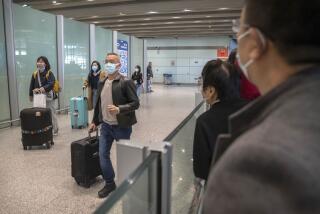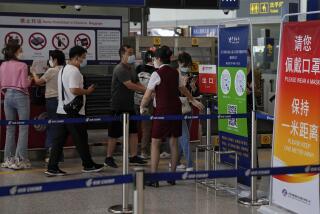Lunar New Year tourism hopes fizzle as Chinese travelers stay home

- Share via
BANGKOK — Asian countries’ hoped-for boom in Chinese tourists over next week’s Lunar New Year holiday looks set to be more of a blip as most of those traveling are opting not to leave China.
From the beaches of Bali to Hokkaido’s ski slopes, the hordes of Chinese seen in pre-COVID days will still be missing, tour operators say.
It’s a bitter disappointment for businesses that had been hoping lean pandemic times were over after Beijing relaxed travel restrictions and stopped requiring weeks-long quarantines. Still, overseas travel bookings have skyrocketed, suggesting it’s only a matter of time until the industry
recovers.
“I think the tourists will return around the end of February or early March at the earliest,” said Thai Travel Agents Assn. President Sisdivachr Cheewarattaporn, noting that many Chinese lack passports, flights are limited and tour operators are still gearing up to handle group travel.
COVID-19 risks are another big factor, as outbreaks have persisted after China’s policy shift, he said in an interview. “People are possibly not ready, or just getting ready.”
For now, the Chinese territories of Macao and Hong Kong appear to be the most favored destinations.
Days before Sunday’s start of the Lunar New Year, tourist spots in the former, such as Senado Square and the Ruins of St. Paul’s, were packed. Gambling floors at two major casinos were largely full, with groups of Chinese visitors at the craps tables.
“I’m so busy every day, and don’t have time to rest,” said souvenir shop owner Lee Hong-soi. He said sales had recovered to about 70% to 80% of the pre-pandemic days, up from nearly nothing just weeks ago.
Kathy Lin was visiting Macao from Shanghai, partly because it was easy to get a visa but also because she was concerned about the risk of catching COVID-19.
“I don’t dare to travel overseas yet,” she said as she took photos near the ruins, originally the 17th century Church of Mater Dei.
That worry is keeping many would-be tourists at home even after China relaxed the “zero COVID” restrictions that sought to isolate cases with mass testing and onerous quarantines.
“The elderly in my family have not been infected, and I don’t want to take any risks. There’s also the possibility of being infected again by other variants,” said Zheng Xiaoli, an elevator company employee in southern China’s Guangzhou.
Although she yearns to travel overseas, she said, “There are still uncertainties, so I will exercise restraint.”
Cong Yitao, an auditor living in Beijing, wasn’t worried about catching the virus, he said, since his whole family has already had COVID-19. But he was put off by testing restrictions and other limits imposed by some countries, including the U.S., Japan and Australia, after China loosened its rules.
“It looks like many countries don’t welcome us,” said Cong, who instead was planning to go to a subtropical destination in China such as Hainan island or Xishuangbanna.
According to the travel services company Trip.com, overseas bookings for the Jan. 21-27 Lunar New Year holidays were up more than fivefold. But the increase was from almost nothing a year ago, when China’s borders were largely closed.
Reservations for travel to Southeast Asia were up tenfold, with Thailand a top choice, followed by Singapore, Malaysia, Cambodia and Indonesia.
Travel to other popular destinations, like Bali and Australia, has been constrained by a lack of flights. But that is changing, with more being added daily.
“You will see an increase, certainly, compared with last year, when China was still closed, but I don’t think you will see a huge surge of outbound travelers to different destinations within Asia-Pacific, let alone Europe or the Americas,” said Haiyan Song, a professor of international tourism at Hong Kong Polytechnic University.
Tourism Australia forecasts that spending by international travelers will surpass pre-pandemic levels within a year. Before COVID-19 hit, Chinese accounted for almost a third of tourist spending there.
Bangkok’s Suvarnabhumi Airport has increased staffing to handle more than 140,000 arrivals a day during the holiday rush, even though group tours from China have yet to resume.
At the Buddhist temple Wat Arun in Bangkok, a Shanghai man who gave only his surname, Zhang, posed with a companion in traditional Thai garments.
“It’s very cold in China, and Thailand has summer weather,” said Zhang, adding that many people had booked tickets to escape his frigid, damp city.
Still, for many Chinese, the allure of world travel has been eclipsed, for now, by a desire to head to their hometowns to see their families, three years after the first major coronavirus outbreak struck in the central city of Wuhan.
Isabelle Wang, a finance worker in Beijing, has traveled to Europe, the Middle East and parts of Asia. After three years of a slower-paced life during the pandemic, her priority is to be reunited with her family in Shangrao, a city in southern China.
“There’s still a lot of time remaining in our lifetimes,” she said, “and there will certainly be opportunities to go abroad later when we want to.”
More to Read
Sign up for Essential California
The most important California stories and recommendations in your inbox every morning.
You may occasionally receive promotional content from the Los Angeles Times.













